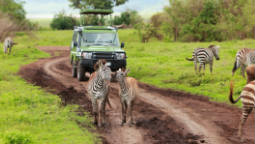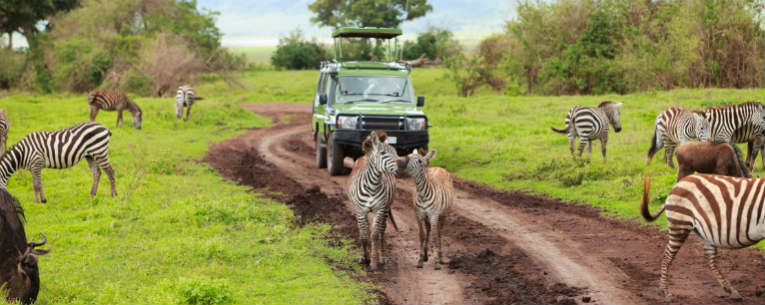An African safari tops many travelers’ bucket lists, and for good reason. A tour of the Serengeti, the Okavango Delta or Kruger National Park is the best way to see stunning sunsets, breathtaking migrations and the so-called Big Five: rhinoceros, elephant, buffalo, lion and leopard.
For most 50-plus travelers, there are only two things standing in the way of their safari dreams: the cost and the challenge. The average African safari price is around $800 to $1,000 per person, per night, according to Travel+Leisure.1 That doesn’t include airfare. And for some, the word “safari” evokes dust storms, biting flies, venomous snakes and flimsy tents.
The truth is, there are plenty of safaris that are affordable and comfortable, although some are a little cushier than others. Here are four of the best African safaris for 50+ travelers on a budget.
1. Self-drive African safaris
Self-drive safaris are just that: You rent a car, stuff it with supplies and head off into the wild. You have the freedom to explore the destinations at your leisure, and you can take all the photographs you want without elbowing other tourists. A self-drive safari doesn’t necessarily mean roughing it. You can stay at cozy safari lodges instead of camping; or, for a fee, a travel agency can help set your route and arrange lodging. It’s good to be overcautious if you’re planning a self-drive safari, however. Thoroughly research fuel stops, check driving times between destinations (maps can be deceiving) and pack more water than you think you’ll need.
One of the best places to do a self-drive safari is Namibia, which is safe and accessible even in a 2WD rental car (although a four-wheel-drive vehicle will allow you to access more remote areas.) Rental car insurance is a must. Lonely Planet suggests driving to the majestic plateaus of Waterberg National Park, the wind-swept dunes of Namib-Naukluft National Park, and the watering holes of Etosha National Park, home to the world’s largest population of black rhino.2
2. Budget camping African safaris
The great national parks of Africa all have campgrounds, but amenities vary. Some have swimming pools and restaurants; others have nothing — not even water. For 50-plus travelers, the best way to do a budget camping safari is with a tour operator that provides equipment, meals and transportation.
Serengeti Pride offers a budget camping safari in Tanzania, in which guests stay at public campgrounds but enjoy the cooking and clean-up services of a chef and a guide. The downside: cold showers. The upside: a five-day safari through the Rift Valley and Serengeti Plains starts at just $1,200 per person. Other operators offer camping safaris with a little more comfort: hot water, raised camp beds and sundowner cocktails.
3. Overlanding African safaris with a group
In an overlanding safari, you’ll join a small group, a guide and a driver aboard a rugged, custom-built truck. Some overland safaris stay at campgrounds each night, while others include some lodge stays. If you like a soft bed each night, look for an overland safari labeled “comfort” or “accommodated.” But don’t expect to sit back and relax; everyone is expected to assist with preparing meals, cleaning up and other chores.
Intrepid travelers may choose an extended overland safari that journeys across several countries. African Overland Tours offers one tour that lasts 58 days, traveling through Uganda, Tanzania, Malawi, Zambia, Zimbabwe, Botswana and Namibia before coming to an end in Cape Town, South Africa. Despite the length, this is a surprisingly affordable safari: The base price is $5,516, which works out to less than $100 per day.
4. Luxury safari lodges in the off-season
To save money while still enjoying creature comforts, book a stay at a luxury safari lodge in the low, or rainy season. Prices may be 30 to 40 percent cheaper.3 You can also expect smaller crowds, which means the chance to have more intimate encounters with wildlife. And your bed will be soft, your views picture-perfect and your dinners delicious.
• In Kenya and Tanzania, prices drop during the wet seasons: March to June and October to December. The rain is occasional, not constant, and this is the best time to see animals with their babies.4
• In South Africa, the off season is May-July, “when the weather is cooler, animal sightings are better, and prices are lower,” Travel + Leisure reports. Rooms at luxury lodges can be had for hundreds less than in the high season.
• In Botswana, November to April is the “green season,” when it rains often and the plains are lush. It’s also the best time for birding.5
• If you’re seeking gorillas in Uganda, you can get discounts in April, May and November.6
When you’re traveling to remote areas on safari, it’s crucial to protect yourself and your vacation investment with Allianz Travel Insurance. The OneTrip Premier Plan is a popular choice for safari-style adventure travel, with up to $50,000 in emergency medical coverage and up to $1 million in emergency medical transportation. Also, kids 17 and under are covered free when traveling with a parent or grandparent (not available on policies issued to Pennsylvania residents). Get a quote today.
Related Articles








Share this Page